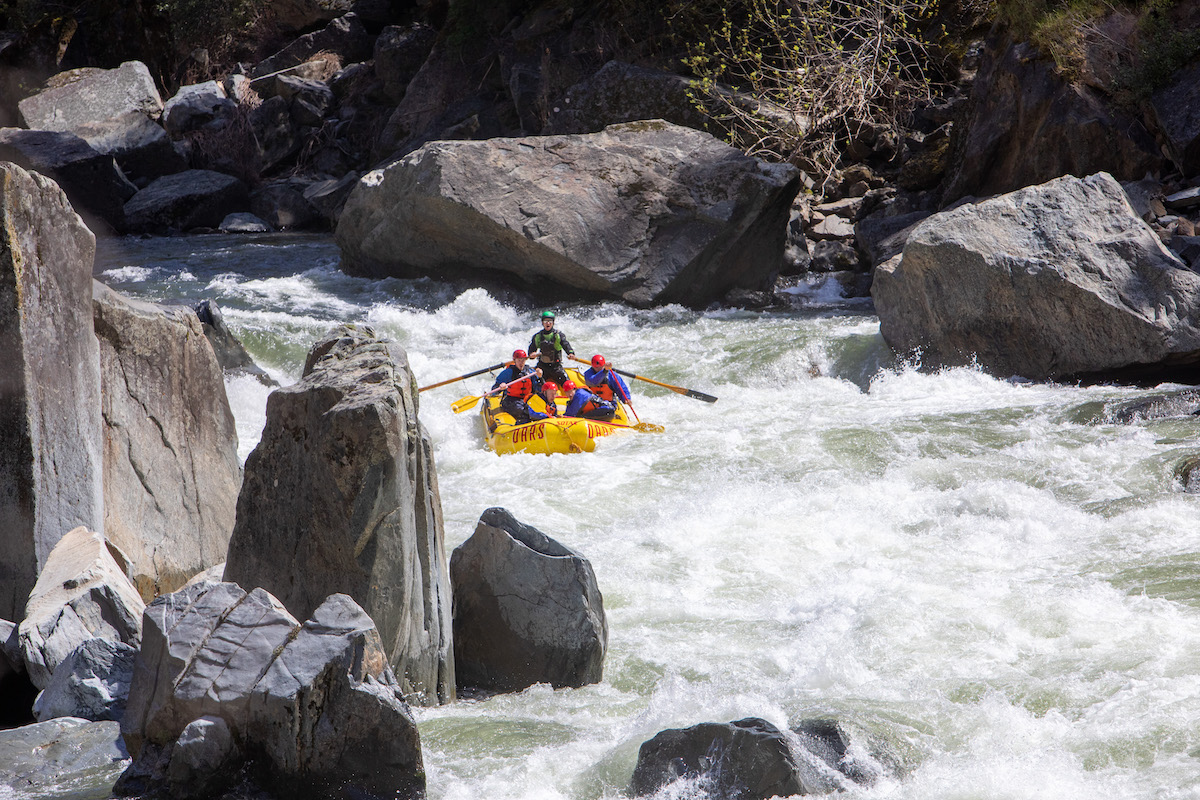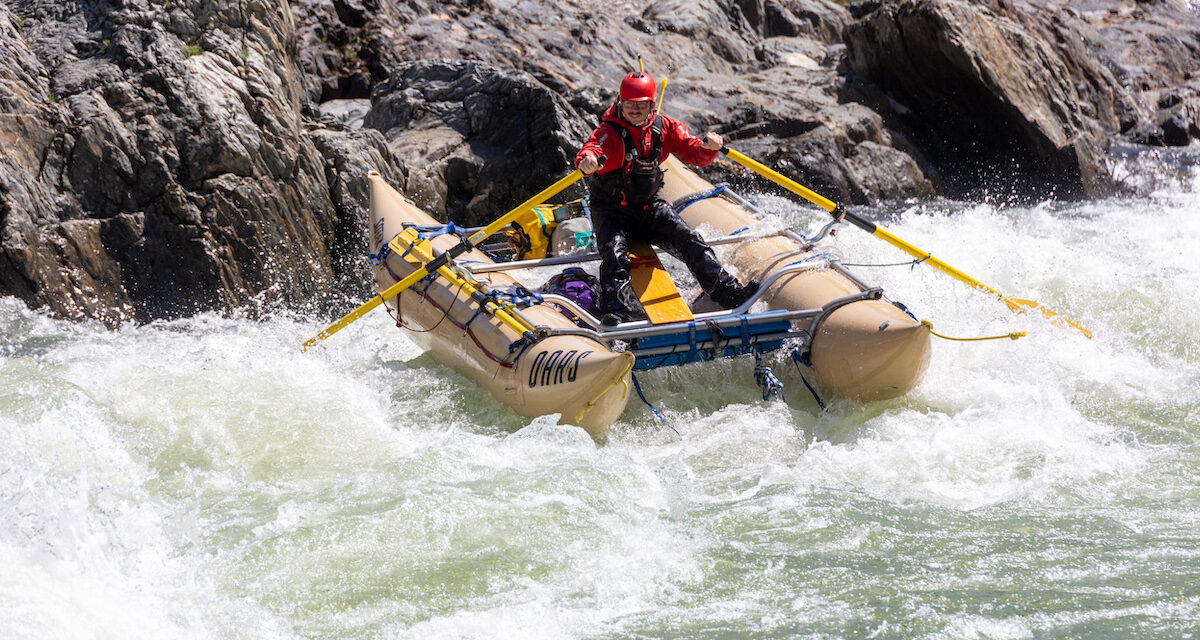- Jerry Meral: Champion of River Conservation for 50 Years - 07/11/2024
- Jerry Ashburn: Adventure Pioneer to Riverside Host - 04/24/2024
- Tulare Lake: Welcome Back Pa’ashi - 09/15/2023
The big runoff has raft guides on their toes
With 2023’s record snowpack and the “great runoff” in full swing, whitewater paddlers are excited for an extended season. Equally excited are casual participants who want to tap into the fun. This has had outfitters across California busy preparing for a season to remember. With the high-water period lasting late into summer, guides have been going the extra length to make experiencing the magic of big water available to everyone this summer, even first timers.
Typically the high-water season in California ends by mid to late June. This year, we could be seeing high-water through the end of July and maybe even into August, requiring heightened skills, experience, and caution throughout the summer. As Jeremiah Copper of Tributary Whitewater Tours notes, “Going with an outfitter is more important than ever this year.”
Outfitters are prioritizing selecting experienced guides who excel in safety, rescue, river reading, strength, stamina, and leadership and communication skills. How do they find such qualified guides?

OARS head guide Brian Kallen shares tips about rowing the Merced River’s Ned’s Gulch rapid at a recent training (Dylan Silver/OARS).
Many guides start by getting their entry-level training through public “guide schools.” These can run for many days and are often where outfitters find new talent, though recommendations and open applications are also a part of the process. For obvious reasons, this year outfitters are relying heavily on experienced guides, especially for their more demanding runs and multi-day trips.
Swiftwater rescue courses, certified by internationally recognized organizations such as Rescue 3 International and Swiftwater Safety Institute, are nearly mandatory credentials. Additionally, wilderness first aid classes are essential for guides to handle health emergencies that may arise, especially on multi-day adventures.

Recovering multiple swimmers at an in-house training on the Truckee River this spring. Photo: Tributary Whitewater Tours
In addition to these standardized courses, outfitters also conduct their own in-house training programs tailored to the skill and experience of their guides. In-house programs are especially important this year after floodwaters reshaped many banks and rapids. The changed dynamics and speed of the water make it more likely rafts may flip and customers will end up in the water. It also means guides can’t necessarily rely on their past knowledge of the river.
So, outfitters have been busy with on-river training sessions, where emergency rescue and recovery drills — such as righting flipped rafts and gathering up swimmers — are practiced. Strong rowing and maneuvering skills are also being drilled. Guides need them to navigate the new routes and to stay nearer than usual to other rafts — to help out or get help.
Travis Hale of OARS says guides typically make three or four trips with empty boats before taking clients out on an unfamiliar or dramatically changed section of river. Hale, who helps train OARS’ Merced and Stanislaus River guides, also watches how each rower works with other guides. “As much as rafting is an individual sport it is a team sport too.”
Training schedules for most companies this season have been complicated this year too. At some locations, some guides started training as early as March. In other cases, like the Stanislaus and the Tuolumne Rivers, where washed out roads and near peak flows made commercial trips difficult in early season, guides will train into June.
Finally, companies have also ramped up safety protocols, putting extra safety boaters and emergency protocols in place.

Garret Thomason testing his limits at a recent training on the Merced River. Photo: Dylan Silver/OARS
EVERYONE’S ON THEIR TOES
Attention to detail extends beyond the guides themselves. Office staff is carefully trained to coach and relay the proper information to participants before they book their trips. Don’t be surprised to have someone ask you about your height, weight and physical condition. Screening has become more rigorous, ensuring that clients possess the necessary skills and mindset for the adventure. Minimum age limits have been raised at least through July. You may also be asked to do a “swim test” and show you can climb back into the boat before launching.
Rely on the judgment of the outfitters and be flexible if they recommend an alternative. Outfitters act in the clients’ best interests, but clients need to make good decisions too.

A guide practices taking clients through the notorious Class V drop on the North Yuba’s Boss Moss rapid this spring. Photo: Tributary Whitewater Tours
WHAT ABOUT PRIVATE TRIPS?
While rafting with reputable outfitters and experienced guides instill confidence, caution is advised when venturing on private trips or with less experienced individuals. Even a professional guide in a casual setting can pose risks.
It is crucial to verify the skills and experience of friends claiming expertise similar to professionals. Moreover, those considering taking friends out should remember that early-season high water is not the ideal time to introduce newcomers to the sport.

Merced River rafting with guides on a training trip. Photo Dylan Silver/OARS
LATE SEASON PADDLING
There will be great paddling late into fall this year, but it is worth noting that many skilled raft and river guides spend their winter months working as ski instructors and patrollers on ski slopes. With the potential for premium boating post-Halloween, outfitters are already considering staffing strategies. So get it while you can, especially as flows moderate and the weather warms through July and August. Look for that to be the peak period to balance fun and safety, though the fit and adventurous might explore a one-day blast down the full 21 miles of the South Fork of the American River or a high water Merced, Stanislaus, or Kern River trip in June.
Main Image: OARS guide and manager Jacob Motsinger rows the backup “safety cat” at a recent training on the Merced River. Photo by Dylan Silver / OARS
Read other articles by Anthea Raymond here













